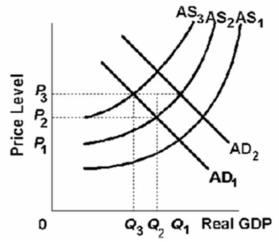Multiple Choice
Refer to the graph below.Assume that the economy is in initial equilibrium where AS1 intersects AD1.Then a supply shock occurs that shifts AS1 to AS2.If the government counters with an expansionary fiscal policy that shifts AD1 to AD2, then it is most likely that: 
A) AD2 will shift to AD1.
B) AS2 will shift to AS1.
C) AS2 will shift to AS3.
D) AS2 will shift to AS3 and AD2 will shift to AD1.
Correct Answer:

Verified
Correct Answer:
Verified
Q41: Adverse aggregate supply shocks would result in<br>A)a
Q107: <img src="https://d2lvgg3v3hfg70.cloudfront.net/TB6686/.jpg" alt=" Refer to the
Q108: Other things equal, an increase in the
Q110: Economists often recommend active monetary policy, and
Q111: <img src="https://d2lvgg3v3hfg70.cloudfront.net/TB6686/.jpg" alt=" Refer to the
Q113: The short-run aggregate supply curve:<br>A)Becomes steeper the
Q114: <img src="https://d2lvgg3v3hfg70.cloudfront.net/TB6686/.jpg" alt=" The long-run Phillips
Q115: Many economists doubt the proposition that supply-side
Q116: The Laffer Curve suggests that lower tax
Q117: Refer to the graph given below. <img